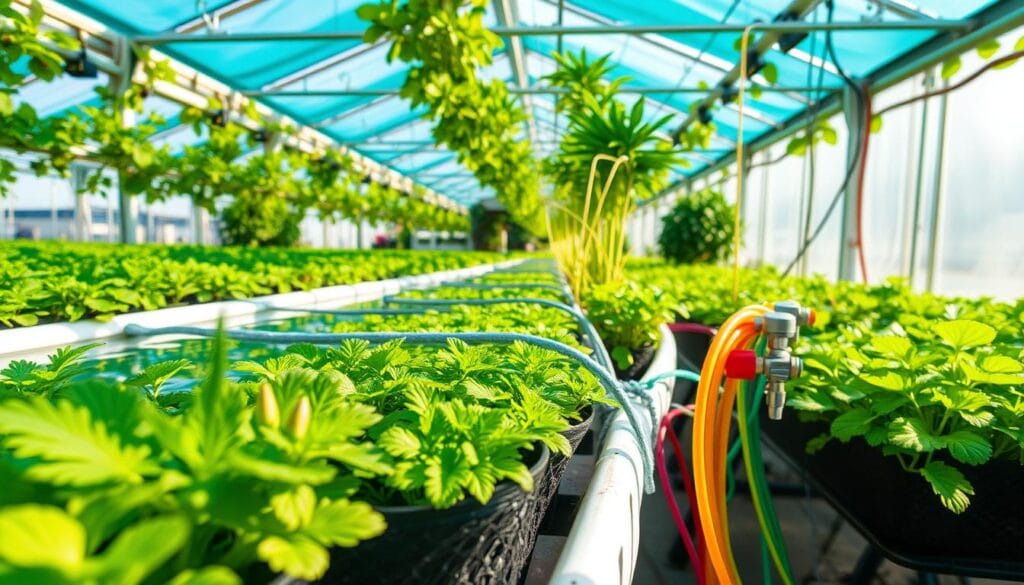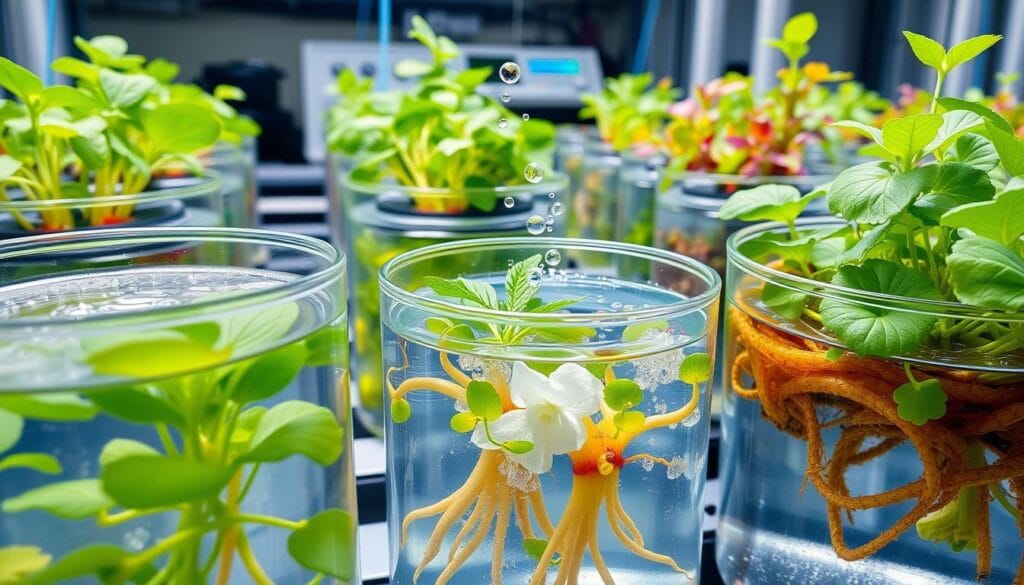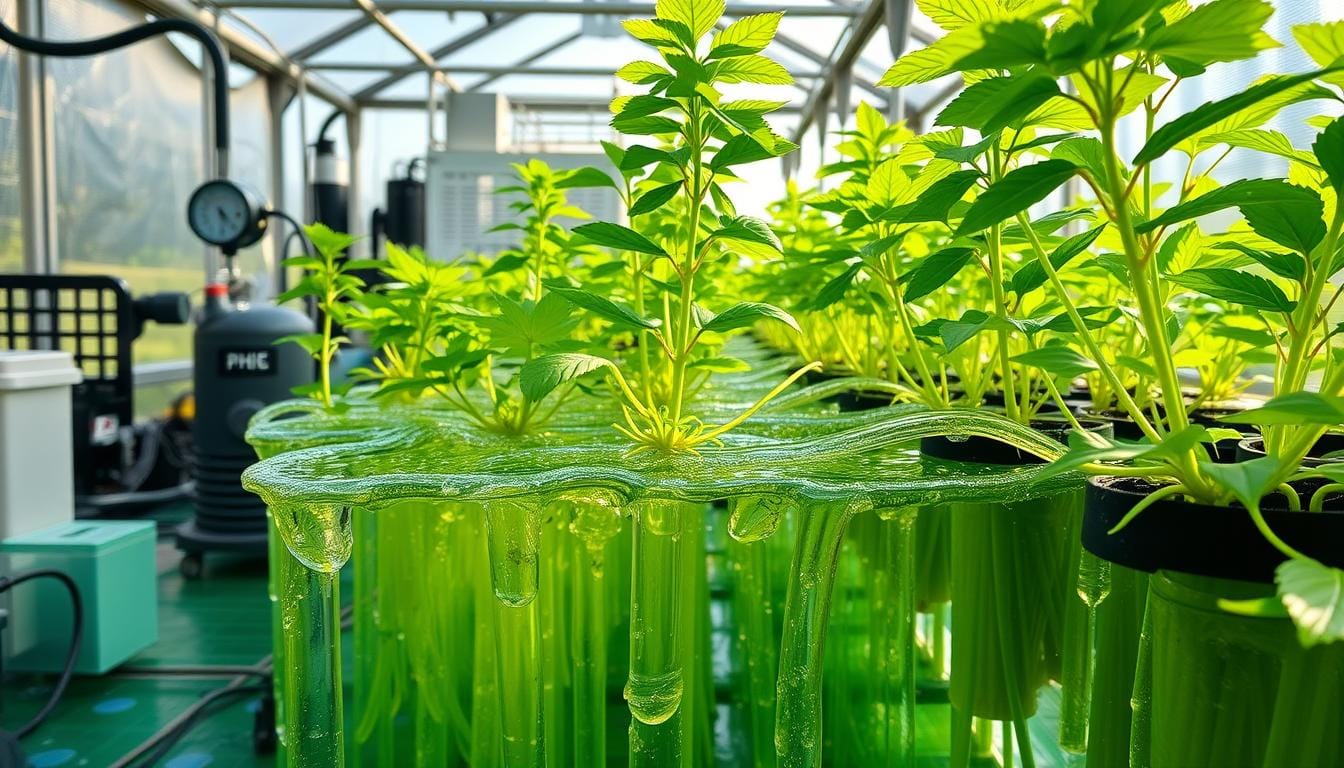Hydroponic water is the foundation of a successful hydroponic journey. Managing it effectively is vital for a healthy crop. A well-designed hydroponics water system provides your plants with essential nutrients. With the right tools and knowledge, you can create a system that ensures your plants thrive.
Managing hydroponics water well stops diseases and makes sure plants get what they need. Knowing the basics of a hydroponic system and the tools for managing water will help you grow a successful crop. This article will explore hydroponic water management, including water quality, nutrients, and the need for a well-designed system.
Key Takeaways
- Managing hydroponics water is key for a healthy and thriving crop
- A well-designed hydroponic water system delivers the right amount of hydroponic nutrients
- Proper water management prevents water-borne diseases
- Understanding the basics of a hydroponic water system is essential for success
- Essential equipment is needed for effective water management
- Hydroponic water quality plays a significant role in plant growth
- A balanced hydroponic water system fosters robust plant growth
Understanding Your Hydroponic Water System Basics
Hydroponic gardening relies on a well-designed water system for plant growth. This system is key for your plants to get the nutrients and water they need. Knowing how it works is vital for success.
Your system has a reservoir, pumps, and irrigation lines. The reservoir holds the nutrient-rich solution. Regular monitoring of the system ensures plants get the right nutrients and water.
Components of a Hydroponic System
- Reservoir: holds the nutrient-rich solution
- Pumps: circulate the solution to the plants
- Irrigation lines: deliver the solution to the plants
Water Quality Requirements
Water quality is key in hydroponic gardening. pH, temperature, and nutrient levels impact plant health and growth.
| Factor | Optimal Range |
|---|---|
| pH | 5.5-6.5 |
| Temperature | 65-75°F |
| Nutrient levels | varies by plant type |
Essential Equipment for Water Management
To manage your hydroponic water system well, you need certain equipment. This includes water testing kits, pH adjusters, and nutrient solutions. With the right knowledge and tools, you can create a great growing space for your plants. Enjoy a successful indoor hydroponics experience.
The Role of Water Quality in Hydroponic Success
Starting with hydroponics means understanding water quality is key. Water quality affects plant growth, so it’s important to check pH, temperature, and hydroponic nutrient levels. This helps your plants grow well.
To succeed, you need the right hydroponic supplies. This includes a good water testing kit and a system for managing nutrients. Here are important water quality factors to watch:
- pH levels: Most plants thrive in a pH range of 5.5 to 7.0.
- Temperature: The best temperature for hydroponics is between 65-75°F (18-24°C).
- Nutrient levels: It’s important to keep hydroponic nutrients balanced. Both excessive and insufficient pH levels can damage your plants.
Knowing and adjusting water quality helps your hydroponic system work well. This leads to healthier plants, more yields, and a successful hydroponic journey. Always choose high-quality hydroponic supplies and follow best practices for nutrient management.
With the right knowledge and tools, you can make a hydroponic system thrive. Focus on water quality and use the best hydroponic nutrients and supplies, and you’ll be on your way to success.
| Parameter | Ideal Range |
|---|---|
| pH | 5.5-7.0 |
| Temperature | 65-75°F (18-24°C) |
| Nutrient Levels | Balanced and optimized |
Mastering Hydroponic Nutrients and Solution Management
To get the best results from your hydroponic system, knowing about nutrients and solution management is key. Your plants need the right nutrients to grow well. Nitrogen, phosphorus, and potassium are essential for roots, leaves, and overall health.
A good hydroponic solution has the right mix of nutrients. This includes primary, secondary, and micronutrients. Calcium and magnesium help with growth, while iron and zinc prevent deficiencies. By understanding hydroponic nutrients, you can make a solution that fits your plants’ needs.
- Primary nutrient requirements: nitrogen, phosphorus, and potassium
- Secondary nutrient balance: calcium, magnesium, and sulfur
- Micronutrient balance: iron, zinc, boron, and copper
- pH management: keeping the pH in the right range for your plants
By following these tips and using the right nutrients, you can help your plants grow well. Always check and adjust your solution to match your plants’ changing needs.
| Nutrient | Function | Deficiency Symptoms |
|---|---|---|
| Nitrogen | Leaf growth and development | Yellowing leaves, stunted growth |
| Phosphorus | Root development and flower formation | Purple or red discoloration, weak stems |
| Potassium | Overall plant health and resistance to disease | Weak stems, yellowing leaves, reduced yields |
Monitoring and Maintaining Perfect Hydroponics Water Parameters
To get the best growth from your hydroponic system, keeping the water just right is key. You need to check the water’s temperature, pH, and nutrient levels often. You’ll also need to get the right hydroponic supplies, like water testing kits and pH adjusters, to keep everything balanced and healthy.
When you’re checking your hydroponic system, remember a few important things:
- Water temperature: it should be between 65-75°F (18-24°C)
- pH levels: they should be between 5.5-6.5
- Nutrient levels: make sure they’re balanced for plant growth
Changing the water regularly is also very important. You’ll need to replace some of the water in your hydroponic reservoir with fresh, nutrient-rich water. With the right hydroponic supplies and care, you can make a perfect place for your plants to grow.

Temperature Control Strategies for Hydroponic Solutions
Temperature control is key in managing your hydroponic setup. The best temperature for plants is between 65-75°F (18-24°C). This range helps roots grow well and absorb nutrients. Use heaters, chillers, or thermometers to keep your solution at the right temperature.
Temperature changes can hurt plant growth and health in hydroponics. To avoid this, adjust your setup for each season. In winter, a heater keeps the temperature steady. In summer, a chiller prevents it from getting too hot.
Optimal Temperature Ranges
- 65-75°F (18-24°C) for most plant species
- 55-65°F (13-18°C) for cooler-season crops
- 75-85°F (24-29°C) for warmer-season crops
By controlling the temperature, you create the best environment for your plants. Always check the temperature and adjust it to keep your plants healthy and thriving.
Preventing and Treating Common Water-related Issues
Proper management of your hydroponics water is essential for a thriving garden. Knowing common problems helps you keep your plants thriving. Regular water tests and adjustments are vital.
Issues like nutrient shortages, pH problems, and diseases can harm your plants. Nutrient deficiencies happen when the solution is off. pH imbalances affect how plants absorb nutrients. Waterborne diseases come from dirty water or tools.
To avoid these problems, follow these steps:
- Regularly test your hydroponic water for pH, nutrient levels, and other parameters
- Use a well-balanced nutrient solution and follow the manufacturer’s instructions
- Monitor your system for signs of disease or nutrient deficiencies
- Ensure your equipment and growing area remain clean and sanitized.
Being proactive helps keep your plants healthy. Regular checks and upkeep are essential. This way, you can enjoy a successful hydroponic garden.

For more hydroponic tips, talk to experienced growers or check out reliable sources. With the right knowledge and care, your hydroponic garden will flourish.
| Issue | Cause | Prevention |
|---|---|---|
| Nutrient deficiencies | Inadequate nutrient solutions or improper mixing | Regularly test hydroponic water and adjust nutrient levels |
| pH imbalances | Improper pH levels in hydroponic water | Monitor and adjust pH levels regularly |
| Waterborne diseases | Contaminated water or equipment | Keep equipment and growing area clean and sanitized |
Advanced Water Management Techniques for Maximum Yield
To get the most out of your hydroponic water system, you need to use advanced water management. Start by getting automation systems. These systems watch and control water levels, pH, and nutrients. This makes sure you use water wisely and cut down on waste.
Water recycling is another smart move. It means using water that’s already been used in your hydroponic system. You can do this with a drip irrigation system or a flood and drain system. Recycling water helps you use less water and throw away less.
Resource Optimization Strategies
To make the most of your hydroponic water system, try these strategies:
Select hydroponic supplies designed to reduce waste and optimize water usage.
Make a plan for nutrients that make sure your plants get what they need.
- Keep an eye on water temperature. It can affect how plants grow and take in nutrients.
By using these advanced water management techniques, you can boost your hydroponic system’s performance. Always pick top-notch hydroponic supplies. Also, check your system often to keep it running at its best.
| Technique | Description | Benefits |
|---|---|---|
| Automation Systems | Monitor and control water levels, pH, and nutrient levels | Optimize water usage, reduce waste |
| Water Recycling | Reuse water that has already been used in the system | Reduce water consumption, minimize waste |
| Resource Optimization | Use hydroponic supplies that minimize waste, and implement a nutrient management plan. | Optimize resources, reduce waste |
Essential Tools and Supplies for Water Maintenance
To keep your hydroponic system healthy, you need the right tools and supplies. A good hydroponic supply kit is key. It should have water testing kits, pH adjusters, and nutrient solutions. A hydroponic reservoir is also vital for managing your solution.
Some important tools and supplies include:
- Water testing kits to check pH, nutrient, and oxygen levels
- pH adjusters to keep the pH right for your plants
- Nutrient solutions made for hydroponic systems
- A hydroponic reservoir for storing and managing your solution
With these tools and supplies, you can manage water well. This keeps your hydroponic system healthy and thriving. Always check and adjust your solution for the best results.
Getting the right tools and supplies is worth it. It helps avoid water problems and leads to a good harvest. With a good hydroponic reservoir and solution, your system will flourish.
Conclusion: Implementing Your Hydroponics Water Management Plan
Effective water management is key to a thriving hydroponics system. By learning and applying the techniques shared, you can give your plants the best water and nutrients. This results in vigorous growth and abundant yields.
To start your water management plan, know your system well and what it needs. Keep an eye on pH, temperature, and oxygen levels. Use automation and recycling to save water and cut down on waste.
Being watchful and flexible is important. Always check on your plants and water levels. Make changes when needed. With hard work and the right steps, you can have a hydroponic garden that gives you plenty of healthy food all year.

